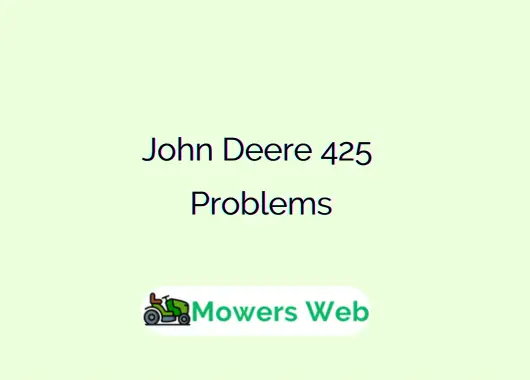John Deere 425 has its share of problems that owners frequently encounter. Knowing these issues and their solutions can help keep your tractor in top working condition for years to come. In this guide, we’ll discuss the most common John Deere 425 problems, what causes them, and how to fix or prevent them.
John Deere 425 Problems
1. Engine Overheating
One of the most reported issues with the John Deere 425 is engine overheating. The liquid-cooled Kawasaki engine is powerful, but if the cooling system is not maintained properly, the tractor may overheat, causing poor performance or engine damage.
Possible causes:
- Clogged radiator or debris blocking airflow
- Low or old coolant
- Faulty water pump or thermostat
- Damaged radiator hoses
Fix:
Regularly clean the radiator and air intake screen to keep debris away. Check coolant levels and top up with the recommended fluid. Replace worn hoses or a faulty water pump if overheating persists.
Related John Deere Power Reverser Transmission Problems(Fixed)
2. Hard Starting or No Start
Another common problem is difficulty starting the engine. Some owners find that their 425 cranks but will not start, or it takes several attempts before firing up.
Possible causes:
- Dirty carburetor or clogged fuel lines
- Old or bad fuel
- Faulty ignition module or spark plugs
- Weak or dead battery
Fix:
Always use fresh gasoline to avoid varnish build-up in the carburetor. Clean the carburetor and replace the fuel filter regularly. Inspect spark plugs for wear and replace them when necessary. If the ignition module is defective, replacing it usually solves the issue. A strong, fully charged battery is also essential for proper starting.
Related John Deere Tractor Dashboard Symbols(ALL + Meanings)
3. Surging or Rough Idle
The John Deere 425 engine may sometimes run unevenly, surge at idle, or lose power under load.
Possible causes:
- Vacuum leaks in the intake system
- Dirty fuel injectors (for fuel-injected models)
- Clogged carburetor jets (for carbureted models)
- Faulty governor adjustment
Fix:
Check for air leaks in the intake manifold and replace gaskets if needed. Clean or rebuild the carburetor to restore proper fuel flow. For fuel-injected models, clean injectors and inspect fuel pressure. Adjusting the governor settings may also smooth out performance.
4. Transmission Issues
The hydrostatic transmission in the John Deere 425 is generally reliable, but owners sometimes report problems such as slow response, slipping, or loss of drive power.
Possible causes:
- Low or contaminated hydraulic fluid
- Worn transmission belt
- Faulty transmission relief valves
- Hydraulic leaks
Fix:
Check the transmission fluid level and replace it if it is dirty or low. Inspect the drive belt for wear and replace it if it is slipping. If hydraulic leaks are present, replace seals or hoses. In rare cases, the relief valves may need adjustment or replacement.
Related John Deere Electric Clutch Problems(5 Causes + Solutions)
5. Power Steering Problems
The John Deere 425 came with power steering, which made it easier to maneuver with heavy attachments. Over time, however, owners may notice difficulty turning or unresponsive steering.
Possible causes:
- Low hydraulic fluid
- Air trapped in the steering lines
- Worn steering cylinder seals
- Faulty steering pump
Fix:
Check fluid levels and top up if necessary. Bleed air from the system to restore smooth steering. If seals in the steering cylinder are leaking, a rebuild kit will usually solve the issue. In more severe cases, the steering pump may require replacement.
6. Electrical Problems
Electrical gremlins are another issue that John Deere 425 owners encounter, especially as the machine ages. Common symptoms include headlights not working, a dead battery, or intermittent starting.
Possible causes:
- Corroded wiring or connections
- Faulty ignition switch
- Weak battery or bad alternator
- Blown fuses
Fix:
Inspect all wiring harnesses for corrosion or loose connections. Clean terminals and apply dielectric grease to prevent further corrosion. Test the alternator to ensure it’s charging properly. Replacing a weak battery or faulty ignition switch usually restores proper function.
Related John Deere 325G Problems(5 Causes + Solutions)
7. Fuel Pump Failure
Some owners of the John Deere 425 report fuel delivery issues caused by a failing fuel pump. Symptoms include sputtering, stalling, or complete engine shutdown.
Possible causes:
- Weak or worn-out fuel pump
- Clogged fuel lines
- Faulty fuel pump relay
Fix:
Test the fuel pump for adequate pressure. If it’s weak, replace it with a compatible part. Ensure that fuel lines are clean and free of blockages. In some cases, replacing the fuel pump relay resolves the issue.
8. PTO (Power Take-Off) Problems
The PTO system allows the John Deere 425 to power attachments such as mowers, tillers, and snow blowers. When it fails, attachments won’t engage properly.
Possible causes:
- Faulty PTO switch
- Worn PTO clutch
- Electrical wiring issues
Fix:
Check the PTO switch for proper function and replace it if necessary. Inspect the clutch for wear and adjust or replace it if it is slipping. Electrical wiring to the PTO should be inspected and repaired if corroded or broken.
Final words
The John Deere 425 remains a dependable workhorse, even decades after its production. While common issues like overheating, hard starting, transmission troubles, and electrical faults can be frustrating, most problems are due to age and regular wear. With proper maintenance, cleaning, and timely replacement of worn parts, the 425 can continue to deliver years of reliable service.
If you own a John Deere 425, staying ahead of these problems by performing routine checks and servicing will help minimize downtime and keep your tractor performing at its best.




